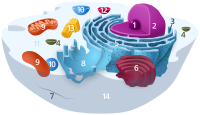
Photo from wikipedia
Abstract The exocyst is the main plasma membrane vesicle-tethering complex in eukaryotes and is composed of eight different subunits. Yet, in plant genomes, many subunits display multiple copies, thought to… Click to show full abstract
Abstract The exocyst is the main plasma membrane vesicle-tethering complex in eukaryotes and is composed of eight different subunits. Yet, in plant genomes, many subunits display multiple copies, thought to reflect evolution of complex subtypes with divergent functions. In Arabidopsis thaliana root endodermal cells, the isoform EXO70A1 is required for positioning of CASP1 at the Casparian Strip Domain, but not for its non-targeted secretion to the plasma membrane. Here, we show that exo84b resembles exo70a1 mutants regarding CASP1 mistargeting and secretion of apoplastic proteins, but exo84b additionally affects secretion of other integral plasma membrane proteins. Moreover, conditional, cell-type-specific gene editing of the single-copy core component SEC6 allows visualization of secretion defects in plant cells with a complete lack of exocyst complex function. Our approach opens avenues for deciphering the complexity/diversity of exocyst functions in plant cells and enables analysis of central trafficking components with lethal phenotypes.
Journal Title: Plant Physiology
Year Published: 2022
Link to full text (if available)
Share on Social Media: Sign Up to like & get
recommendations!